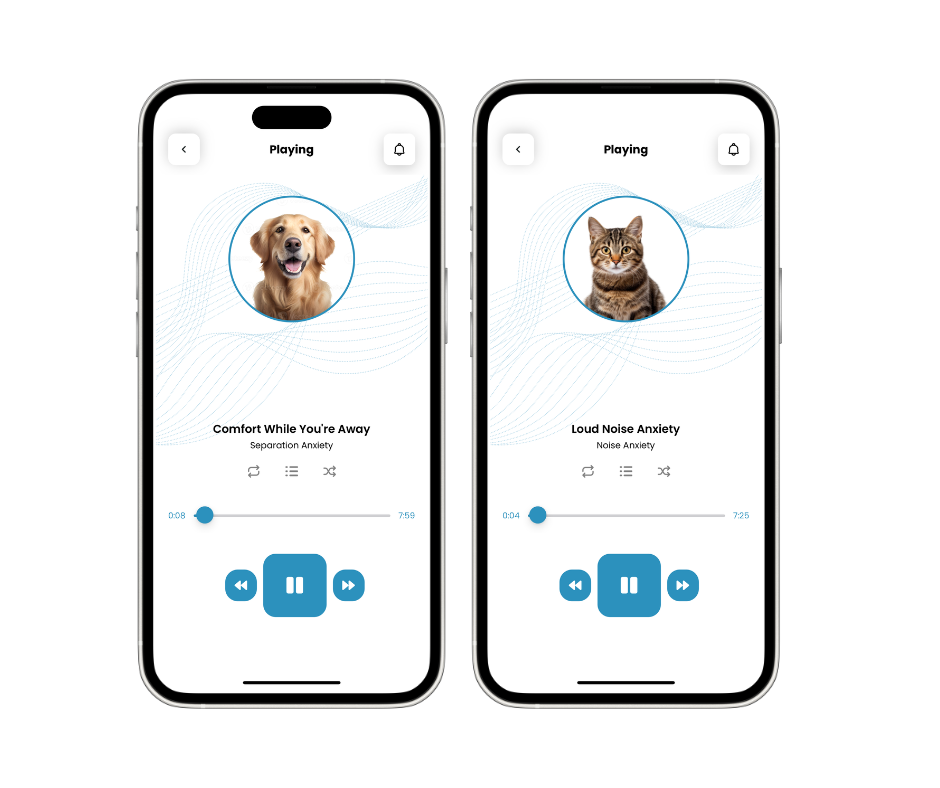Biometric Study Proves Canine-Specific Music Mitigates Stress Levels
Printed in International Animal Health Journal (volume 9, issue 2), published in 2022.
Canine behavioural stress is often triggered by their acute hearing to sounds in the environment. Dogs can hear from 67Hz to 45,000 Hz which is more than two times higher than human hearing which is 20Hz-20,000Hz. To modify behavioural stress in dogs, Janet Marlow, Founder of Pet Acoustics innovated a science-based music process specifically for canine, feline and equine acute hearing.
The benefits of this music in the canine listening environment has been proven in previous studies with results showing calm and a more balanced behaviour. To further understand the calming effects, this new study was initiated to analyse the biometric data of mostly small dog breeds in particular while listening to the species- specific designed music. Why a focus on small dog breeds? Behaviourally, small dog breeds show more fearful and anxious behaviours for various reasons: their comparative size creates a threatened and defensive posturing; owners tend to be overprotective, limiting social confidence; their sonic and vibrational environment triggers an intense physical response. For example, a dog may exhibit compulsive grooming by repeatedly licking or chewing at their skin and fur to help relieve their anxious feelings. Therefore, determining the calming effects of canine- specific music on a biometric level for small dog breeds can provide a tool that promotes calm behavior for a longer, healthier life.
Purpose of Study
The study began in January, 2022, with the purpose of documenting each dog’s biological responses when the canine music was playing and comparatively, when the music was not playing. The music was disbursed by the pre-loaded, Pet Acoustics Pet Tunes Bluetooth® speaker and placed near the dog. The canines for the test were provided by Ron Pia, canine behaviourist in Australia, who facilitated the study. The dogs were volunteered by their owners to participate in the study, with a stay over in a home where the testing took place. Each dog’s daily schedule included rest, walks and play activity. Twenty dogs were monitored, one by one, of different ages and breeds which included: West Highland Terrier, Beagle, Long Haired Chihuahua, Cavalier King Charles Spaniel, French Bulldog, Lagotto Romagnolo, Pomeranian, English Springer Spaniel, Border Collie, Labradoodle, Poodle and a German Shepherd. The ages ranged from six months to twelve years.
Each dog’s vital signs were documented in real time by wearing the Petpace smart collar. The Petpace collar measured each dog’s pulse rate, HRV rate and activity levels with the music playing and without the music playing.
The purpose of this study is to support the hypothesis that canine-specific music induces a physiological and behavioral calmer state in small dog breeds as well as larger dog breeds, helping them modify stress-triggered behavior for better health and balance. The twenty dogs in this study were male and female, neutered and not neutered, different sized breeds and different ages.
The four month biometric study monitored twenty varying small and larger dog breeds of different ages by measuring their pulse rate, HRV rate, and activity level determining the effects of the music to mitigate anxiety. Each dog's vital signs and behavior patterns were collected by wearing the Petpace smart collar.
Data of Each Dog Tested
Biometric Measures Tested
Pulse
Pulse, or heart rate, is the measurement of the number of times a pet’s heart beats per minute. Heart rate is one of the most important vital signs caregivers can measure for a pet. When the heart rate is measured peripherally by palpating or sensing the pulse in a limb it is called pulse. The job of the heart is to pump blood throughout the body, supplying oxygen to the cells. A pet’s heart rate is controlled by a sophisticated mechanism that takes into account the oxygen demand from the cells and makes sure the heart is able to provide it. For example, when a dog runs, its muscles work hard and consume a lot of oxygen. Therefore, the heart must work faster to supply the demand. Fear is another condition that is associated with increased heart rate in pets. When a pet (or a human) is afraid, the body gets ready for a fight or flight situation, and prepares for the anticipated increase in demand for oxygen.
Heart Rate Variability (HRV)
Heart Rate Variability (HRV) is a statistical analysis of the small variations in time intervals between heartbeats. The variations are innate and normal physiological phenomena. Studies have shown that changes in HRV are associated with a wide range of diseases as well as pain, stress, and obesity. HRV is recognised as a marker for autonomic nervous system activity. The autonomic (parasympathetic and sympathetic) nervous systems as well as hormonal factors provide the main input to the heart’s pacemaker, and the beat-to-beat interval variability is a reflection of the balance between these two. High HRV indicates a good fitness level and a healthy heart and nervous system. Low HRV is associated with stress, pain, heart disease and other pathologies.
Activity Score
Activity Score is a calculated value that provides a quantitative representation of a pet's activity during the selected time range. It is based on summarising all the separate activity readings and producing a total value for the pet's overall activity. What is known is that monitoring and analysing activity patterns and levels can provide valuable medical insights. For example, a decline in activity levels may indicate the development of a disease causing pain or weakness. Activity is also affected by stress levels but this effect is more complex. Some dogs respond to stress by excessive barking, pacing or shaking, while others respond by hiding or loss of appetite. The study evaluated each dog’s activity levels.
Materials
Pet Acoustics and Petpace
There were two catalysts used for the study; the Pet Acoustics canine-specific music and the Petpace smart collar. Each of the twenty dogs wore the PetPace collar for approximately six hours within a twenty-four hour period during various activities. Biometric data was collected by an array of sensors in the collar device. The music was played for three hours. After this time, the music was turned off for three hours in the area of the collared dog for comparison. During the six hour session with the collar, the data was collected in real time and could be seen on a cloud-based analysis engine program provided by Petpace.
Pet Acoustics Canine-Specific Music
The canine-specific music used in the study is a science- based process with measurable and repeatable results to calm behavioral stress in dogs. Different from music for human hearing, the instruments, frequency and decibel levels are digitally modified in original compositions to accommodate the comfort range of canine acute hearing. Species-specific music is a copyrighted, proprietary process innovated in 1997 by Janet Marlow, sound behaviourist and composer for Pet Acoustics.
Janet Marlow, founder of Pet Acoustics and Sound Behaviorist, at the Litchfield Veterinary Clinic.
Methods
After the first dog’s testing was completed, the collar was removed and placed on the next dog visiting the testing site. The same method was done with each of the other dogs collecting the biometric data every two minutes during the sessions. Each dog was tested with half the session without the music playing and then with the music playing.
When the music wasn’t playing, each dog heard and responded to the natural sounds of home life as well as several daily walks and playtime. During the four month period however, there were sounds of passing intense thunderstorms with lightning. Within the testing home of the twenty dogs, there were multiple dogs in the same environment.
Results
When looking at the aggregated data for all the dogs that participated in the study, we can see that the median pulse rate was lower, the median HRV was higher, and the median activity score was slightly lower when the dogs were exposed to the calming music compared to these values when no music was being played.
Pulse
Pulse rate decreased in response to music. The average of median pulse rates was 5.9% lower during times when the dogs were exposed to the music (57.95) compared to times when the dogs were not exposed to the music (61.58).
HRV
Music caused the HRV to increase (high HRV indicates lower stress level). In this study, the overall average of median HRVs was 1.3% higher during times when the dogs were exposed to the music (11.63) compared to times when the dogs were not exposed to the music (11.48).
Activity
The activity score value showed varying results. The median activity score was lower for 10 dogs out of the 20 that participated in the study, and higher for the other 10 dogs. The total average of median Activity Scores was 3.5% lower during times when the dogs were exposed to the music (31.84) compared to times when the dogs were not exposed to the music (32.98).
Conclusions
The Pet Acoustics music that was tested in this study caused physiological and behavioural changes indicating a calmer state for dogs. The pulse rate was lower and HRV was higher in response to music, both being physiological changes associated with a calmer state (lower relative sympathetic tone, or a weaker “fight or flight” state).
All these findings supported the hypothesis of a calming effect as a result of the dogs listening to the music shown by the biometric data. The most significant finding was the HRV, which showed a considerable elevation from baseline, even more than what we see with the pulse. HRV was lower when the sympathetic tone (fight or flight mode) was higher, and vice versa. Therefore, a calm animal should have a higher HRV.
Aggregate Data
Benefits for Canine Welfare
The results of the study proved that canine-specific music modifies stress behaviours in small dogs. The stress scores were significantly lower in dogs listening to the music as compared with no music. There were no significant differences when comparing the sex, age or breed of the dogs, whether they were neutered or not and whether they were outdoors or indoors, all responded positively to the music.
Therefore, small dog breeds inclination for more intense stress responses to their environment can be successfully mitigated by the use of canine-specific music regardless of the owners consistency of training or environment. Additionally, this study showed larger sized dogs have the same ratio of biometric calming response to the music.
Applications and Benefits
For veterinarians – When playing Pet Acoustics canine- calming music, there is a reduction in stress which allows the team to conduct better physical examinations and take more accurate vitals. Broadcasting this music in the waiting rooms of veterinary clinics can also help to ease the anxiety of waiting dogs.
More Applications
Modify stress for separation anxiety
Modify stress in animal shelters
Calmer response to thunderstorms and firework events Less stressful breeding and birthing
Use for post-surgery healing
Use for travel anxiety
Contributors
Janet Marlow
Founder and Sound Behaviorist, Pet Acoustics
Dr. Asaf Dagan
Chief Veterinary Scientist, PetPace
Ron Pia
Founder, The Pet Calmer







